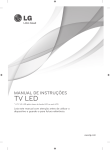Download LG 32LA62**-Z* User's Manual
Transcript
Internal Use Only North/Latin America Europe/Africa Asia/Oceania http://aic.lgservice.com http://eic.lgservice.com http://biz.lgservice.com LED TV SERVICE MANUAL CHASSIS : LD33B MODEL : 32LA62** 32LA62**-Z* CAUTION BEFORE SERVICING THE CHASSIS, READ THE SAFETY PRECAUTIONS IN THIS MANUAL. P/NO : MFL67727123 (1306-REV01) Printed in Korea CONTENTS CONTENTS . ............................................................................................. 2 SAFETY PRECAUTIONS ......................................................................... 3 SERVICING PRECAUTIONS..................................................................... 4 SPECIFICATION........................................................................................ 6 ADJUSTMENT INSTRUCTION............................................................... 14 BLOCK DIAGRAM ................................................................................. 21 EXPLODED VIEW .................................................................................. 22 SCHEMATIC CIRCUIT DIAGRAM .............................................................. Copyright © LG Electronics. Inc. All rights reserved. Only for training and service purposes -2- LGE Internal Use Only SAFETY PRECAUTIONS IMPORTANT SAFETY NOTICE Many electrical and mechanical parts in this chassis have special safety-related characteristics. These parts are identified by in the Schematic Diagram and Exploded View. It is essential that these special safety parts should be replaced with the same components as recommended in this manual to prevent Shock, Fire, or other Hazards. Do not modify the original design without permission of manufacturer. General Guidance Leakage Current Hot Check (See below Figure) Plug the AC cord directly into the AC outlet. An isolation Transformer should always be used during the servicing of a receiver whose chassis is not isolated from the AC power line. Use a transformer of adequate power rating as this protects the technician from accidents resulting in personal injury from electrical shocks. It will also protect the receiver and it's components from being damaged by accidental shorts of the circuitry that may be inadvertently introduced during the service operation. If any fuse (or Fusible Resistor) in this TV receiver is blown, replace it with the specified. When replacing a high wattage resistor (Oxide Metal Film Resistor, over 1 W), keep the resistor 10 mm away from PCB. Keep wires away from high voltage or high temperature parts. Do not use a line Isolation Transformer during this check. Connect 1.5 K / 10 watt resistor in parallel with a 0.15 uF capacitor between a known good earth ground (Water Pipe, Conduit, etc.) and the exposed metallic parts. Measure the AC voltage across the resistor using AC voltmeter with 1000 ohms/volt or more sensitivity. Reverse plug the AC cord into the AC outlet and repeat AC voltage measurements for each exposed metallic part. Any voltage measured must not exceed 0.75 volt RMS which is corresponds to 0.5 mA. In case any measurement is out of the limits specified, there is possibility of shock hazard and the set must be checked and repaired before it is returned to the customer. Leakage Current Hot Check circuit Before returning the receiver to the customer, always perform an AC leakage current check on the exposed metallic parts of the cabinet, such as antennas, terminals, etc., to be sure the set is safe to operate without damage of electrical shock. Leakage Current Cold Check(Antenna Cold Check) With the instrument AC plug removed from AC source, connect an electrical jumper across the two AC plug prongs. Place the AC switch in the on position, connect one lead of ohm-meter to the AC plug prongs tied together and touch other ohm-meter lead in turn to each exposed metallic parts such as antenna terminals, phone jacks, etc. If the exposed metallic part has a return path to the chassis, the measured resistance should be between 1 MΩ and 5.2 MΩ. When the exposed metal has no return path to the chassis the reading must be infinite. An other abnormality exists that must be corrected before the receiver is returned to the customer. Copyright © LG Electronics. Inc. All rights reserved. Only for training and service purposes -3- LGE Internal Use Only SERVICING PRECAUTIONS CAUTION: Before servicing receivers covered by this service manual and its supplements and addenda, read and follow the SAFETY PRECAUTIONS on page 3 of this publication. NOTE: If unforeseen circumstances create conflict between the following servicing precautions and any of the safety precautions on page 3 of this publication, always follow the safety precautions. Remember: Safety First. General Servicing Precautions 1. Always unplug the receiver AC power cord from the AC power source before; a. Removing or reinstalling any component, circuit board module or any other receiver assembly. b. Disconnecting or reconnecting any receiver electrical plug or other electrical connection. c. Connecting a test substitute in parallel with an electrolytic capacitor in the receiver. CAUTION: A wrong part substitution or incorrect polarity installation of electrolytic capacitors may result in an explosion hazard. 2. Test high voltage only by measuring it with an appropriate high voltage meter or other voltage measuring device (DVM, FETVOM, etc) equipped with a suitable high voltage probe. Do not test high voltage by "drawing an arc". 3. Do not spray chemicals on or near this receiver or any of its assemblies. 4. Unless specified otherwise in this service manual, clean electrical contacts only by applying the following mixture to the contacts with a pipe cleaner, cotton-tipped stick or comparable non-abrasive applicator; 10 % (by volume) Acetone and 90 % (by volume) isopropyl alcohol (90 % - 99 % strength) CAUTION: This is a flammable mixture. Unless specified otherwise in this service manual, lubrication of contacts in not required. 5. Do not defeat any plug/socket B+ voltage interlocks with which receivers covered by this service manual might be equipped. 6. Do not apply AC power to this instrument and/or any of its electrical assemblies unless all solid-state device heat sinks are correctly installed. 7. Always connect the test receiver ground lead to the receiver chassis ground before connecting the test receiver positive lead. Always remove the test receiver ground lead last. 8. Use with this receiver only the test fixtures specified in this service manual. CAUTION: Do not connect the test fixture ground strap to any heat sink in this receiver. Electrostatically Sensitive (ES) Devices Some semiconductor (solid-state) devices can be damaged easily by static electricity. Such components commonly are called Electrostatically Sensitive (ES) Devices. Examples of typical ES devices are integrated circuits and some field-effect transistors and semiconductor “chip” components. The following techniques should be used to help reduce the incidence of component damage caused by static by static electricity. 1. Immediately before handling any semiconductor component or semiconductor-equipped assembly, drain off any electrostatic charge on your body by touching a known earth ground. Alternatively, obtain and wear a commercially available discharging wrist strap device, which should be removed to prevent potential shock reasons prior to applying power to the unit under test. Copyright © LG Electronics. Inc. All rights reserved. Only for training and service purposes 2. After removing an electrical assembly equipped with ES devices, place the assembly on a conductive surface such as aluminum foil, to prevent electrostatic charge buildup or exposure of the assembly. 3. Use only a grounded-tip soldering iron to solder or unsolder ES devices. 4. Use only an anti-static type solder removal device. Some solder removal devices not classified as “anti-static” can generate electrical charges sufficient to damage ES devices. 5. Do not use freon-propelled chemicals. These can generate electrical charges sufficient to damage ES devices. 6. Do not remove a replacement ES device from its protective package until immediately before you are ready to install it. (Most replacement ES devices are packaged with leads electrically shorted together by conductive foam, aluminum foil or comparable conductive material). 7. Immediately before removing the protective material from the leads of a replacement ES device, touch the protective material to the chassis or circuit assembly into which the device will be installed. CAUTION: Be sure no power is applied to the chassis or circuit, and observe all other safety precautions. 8. Minimize bodily motions when handling unpackaged replacement ES devices. (Otherwise harmless motion such as the brushing together of your clothes fabric or the lifting of your foot from a carpeted floor can generate static electricity sufficient to damage an ES device.) General Soldering Guidelines 1. Use a grounded-tip, low-wattage soldering iron and appropriate tip size and shape that will maintain tip temperature within the range or 500 °F to 600 °F. 2. Use an appropriate gauge of RMA resin-core solder composed of 60 parts tin/40 parts lead. 3. Keep the soldering iron tip clean and well tinned. 4. Thoroughly clean the surfaces to be soldered. Use a mall wirebristle (0.5 inch, or 1.25 cm) brush with a metal handle. Do not use freon-propelled spray-on cleaners. 5. Use the following unsoldering technique a. Allow the soldering iron tip to reach normal temperature. (500 °F to 600 °F) b. Heat the component lead until the solder melts. c. Quickly draw the melted solder with an anti-static, suctiontype solder removal device or with solder braid. CAUTION: Work quickly to avoid overheating the circuit board printed foil. 6. Use the following soldering technique. a. Allow the soldering iron tip to reach a normal temperature (500 °F to 600 °F) b. First, hold the soldering iron tip and solder the strand against the component lead until the solder melts. c. Quickly move the soldering iron tip to the junction of the component lead and the printed circuit foil, and hold it there only until the solder flows onto and around both the component lead and the foil. CAUTION: Work quickly to avoid overheating the circuit board printed foil. d. Closely inspect the solder area and remove any excess or splashed solder with a small wire-bristle brush. -4- LGE Internal Use Only IC Remove/Replacement Some chassis circuit boards have slotted holes (oblong) through which the IC leads are inserted and then bent flat against the circuit foil. When holes are the slotted type, the following technique should be used to remove and replace the IC. When working with boards using the familiar round hole, use the standard technique as outlined in paragraphs 5 and 6 above. Removal 1. Desolder and straighten each IC lead in one operation by gently prying up on the lead with the soldering iron tip as the solder melts. 2. Draw away the melted solder with an anti-static suction-type solder removal device (or with solder braid) before removing the IC. Replacement 1. Carefully insert the replacement IC in the circuit board. 2. Carefully bend each IC lead against the circuit foil pad and solder it. 3. Clean the soldered areas with a small wire-bristle brush. (It is not necessary to reapply acrylic coating to the areas). "Small-Signal" Discrete Transistor Removal/Replacement 1. Remove the defective transistor by clipping its leads as close as possible to the component body. 2. Bend into a "U" shape the end of each of three leads remaining on the circuit board. 3. Bend into a "U" shape the replacement transistor leads. 4. Connect the replacement transistor leads to the corresponding leads extending from the circuit board and crimp the "U" with long nose pliers to insure metal to metal contact then solder each connection. Power Output, Transistor Device Removal/Replacement 1. Heat and remove all solder from around the transistor leads. 2. Remove the heat sink mounting screw (if so equipped). 3. Carefully remove the transistor from the heat sink of the circuit board. 4. Insert new transistor in the circuit board. 5. Solder each transistor lead, and clip off excess lead. 6. Replace heat sink. Diode Removal/Replacement 1. Remove defective diode by clipping its leads as close as possible to diode body. 2. Bend the two remaining leads perpendicular y to the circuit board. 3. Observing diode polarity, wrap each lead of the new diode around the corresponding lead on the circuit board. 4. Securely crimp each connection and solder it. 5. Inspect (on the circuit board copper side) the solder joints of the two "original" leads. If they are not shiny, reheat them and if necessary, apply additional solder. 3. Solder the connections. CAUTION: Maintain original spacing between the replaced component and adjacent components and the circuit board to prevent excessive component temperatures. Circuit Board Foil Repair Excessive heat applied to the copper foil of any printed circuit board will weaken the adhesive that bonds the foil to the circuit board causing the foil to separate from or "lift-off" the board. The following guidelines and procedures should be followed whenever this condition is encountered. At IC Connections To repair a defective copper pattern at IC connections use the following procedure to install a jumper wire on the copper pattern side of the circuit board. (Use this technique only on IC connections). 1. Carefully remove the damaged copper pattern with a sharp knife. (Remove only as much copper as absolutely necessary). 2. carefully scratch away the solder resist and acrylic coating (if used) from the end of the remaining copper pattern. 3. Bend a small "U" in one end of a small gauge jumper wire and carefully crimp it around the IC pin. Solder the IC connection. 4. Route the jumper wire along the path of the out-away copper pattern and let it overlap the previously scraped end of the good copper pattern. Solder the overlapped area and clip off any excess jumper wire. At Other Connections Use the following technique to repair the defective copper pattern at connections other than IC Pins. This technique involves the installation of a jumper wire on the component side of the circuit board. 1. Remove the defective copper pattern with a sharp knife. Remove at least 1/4 inch of copper, to ensure that a hazardous condition will not exist if the jumper wire opens. 2. Trace along the copper pattern from both sides of the pattern break and locate the nearest component that is directly connected to the affected copper pattern. 3. Connect insulated 20-gauge jumper wire from the lead of the nearest component on one side of the pattern break to the lead of the nearest component on the other side. Carefully crimp and solder the connections. CAUTION: Be sure the insulated jumper wire is dressed so the it does not touch components or sharp edges. Fuse and Conventional Resistor Removal/Replacement 1. Clip each fuse or resistor lead at top of the circuit board hollow stake. 2. Securely crimp the leads of replacement component around notch at stake top. Copyright © LG Electronics. Inc. All rights reserved. Only for training and service purposes -5- LGE Internal Use Only SPECIFICATION NOTE : Specifications and others are subject to change without notice for improvement. 1. Application range This specification is applied to the LED TV used LD33B chassis. 3. Test method 2. Requirement for Test 1) Performance: LGE TV test method followed 2) Demanded other specification - Safety : CE, IEC specification - EMC : CE, IEC Each part is tested as below without special appointment. 1) Temperature: 25 °C ± 5 °C(77 °F ± 9 °F), CST: 40 °C ± 5 °C 2) Relative Humidity: 65 % ± 10 % 3) Power Voltage : Standard input voltage (AC 100-240 V~, 50/60 Hz) * Standard Voltage of each products is marked by models. 4) Specification and performance of each parts are followed each drawing and specification by part number in accordance with BOM. 5) The receiver must be operated for about 20 minutes prior to the adjustment. 4. Model General Specification No. 1 Item Market Specification Remarks DTV & Analog (Total 37 countries) DTV (MPEG2/4, DVB-T) : 29 countries Germany, Netherland, Switzerland, Hungary, Austria, Slovenia, Bulgaria, France, Spain, Italy, Belgium, Luxemburg, Greece, Czech, Croatia, Turkey, Moroco, Ireland, Latvia, Estonia, Lithuania, Poland, Portugal, Romania, Albania, Bosnia, Serbia, Slovakia, Beralus EU(PAL Market-37Countries) DTV (MPEG2/4, DVB-T2): 8 countries UK(Ireland), Sweden, Denmark, Finland, Norway, Ukraine, Kazakhstan, Russia DTV (MPEG2/4, DVB-C): 37 countries Germany, Netherland, Switzerland, Hungary, Austria, Slovenia, Bulgaria, France, Spain, Italy, Belgium, Russia, Luxemburg, Greece, Czech, Croatia, Turkey, Moroco, Ireland, Latvia, Estonia, Lithuania, Poland, Portugal, Romania, Albania, Bosnia, Serbia, Slovakia, Beralus, UK, Sweden, Denmark, Finland, Norway, Ukraine, Kazakhstan DTV (MPEG2/4,DVB-S): 30 countries Germany, Netherland, Switzerland, Hungary, Austria, Slovenia, Bulgaria, France, Spain, Italy, Belgium, Russia, Luxemburg, Greece, Czech, Croatia, Turkey, Moroco, Ireland, Latvia, Estonia, Lithuania, Poland, Portugal, Romania, Albania, Bosnia, Serbia, Slovakia, Beralus Supported satellite : 22 satellites HISPASAT 1C/1D, ATLANTIC BIRD 2, NILESAT 101/102, ATLANTIC BIRD 3, AMOS 2/3, THOR 5/6, IRIUS 4, EUTELSAT-W3A, EUROBIRD 9A, EUTELSAT-W2A, HOTBIRD 6/8/9, EUTELSAT-SESAT, ASTRA 1L/H/M/ KR, ASTRA 3A/3B, BADR 4/6, ASTRA 2D, EUROBIRD 3, EUTELSAT-W7, HELLASSAT 2, EXPRESS AM1, TURKSAT 2A/3A, INTERSAT10 Copyright © LG Electronics. Inc. All rights reserved. Only for training and service purposes -6- LGE Internal Use Only No. 2 3 4 Item Broadcasting system Program coverage Receiving system Specification 1) PAL-BG 2) PAL-DK 3) PAL-I/I’ 4) SECAM-L/L', DK , BG, I 5) DVB-T 6) DVB-C 7) DVB-T2 8) DVB-S/S2 1 ) Digital TV - VHF, UHF - C-Band,Ku-Band 2) Analogue TV - VHF : E2 to E12 - UHF : E21 to E69 - CATV : S1 to S20 - HYPER : S21 to S47 Remarks Model : *L*V*-Z* (T2 only Model) DVB-S: Satellite ► DVB-T - Guard Interval(Bitrate_Mbit/s) 1/4, 1/8, 1/16, 1/32 - Modulation : Code Rate QPSK : 1/2, 2/3, 3/4, 5/6, 7/8 16-QAM : 1/2, 2/3, 3/4, 5/6, 7/8 64-QAM : 1/2, 2/3, 3/4, 5/6, 7/8 ► DVB-T2 (Model : *L*V*-Z* (T2 only Model)) - Guard Interval(Bitrate_Mbit/s) 1/4, 1/8, 1/16, 1/32, 1/128, 19/128, 19/256, - Modulation : Code Rate QPSK : 1/2, 2/5, 2/3, 3/4, 5/6 16-QAM : 1/2, 2/5, 2/3, 3/4, 5/6 64-QAM : 1/2, 2/5, 2/3, 3/4, 5/6 256-QAM : 1/2, 2/5, 2/3, 3/4, 5/6 Analog : Upper Heterodyne Digital : COFDM, QAM ► DVB-C - Symbolrate : 4.0Msymbols/s to 7.2Msymbols/s - Modulation : 16QAM, 64-QAM, 128-QAM and 256-QAM 5 Scart (1EA) PAL, SECAM 6 Video Input RCA(1EA) PAL, SECAM, NTSC 7 Head phone out 8 Component Input (1EA) 9 HDMI Input (3EA) 10 Audio Input (3EA) 11 12 13 SDPIF out (1EA) USB (1EA) Ethernet Connect(1EA) Antenna, AV1, AV2, Component, HDMI1, HDMI2, HDMI3, USB1, USB2, USB3 Y/Cb/Cr Y/Pb/Pr HDMI1-DTV HDMI2-DTV HDMI3-DTV DVI Audio Component/AV2 AV1 SPDIF out EMF, DivX HD, For SVC (download) Ethernet Connect Copyright © LG Electronics. Inc. All rights reserved. Only for training and service purposes -7- ► DVB-S/S2 - symbolrate DVB-S2 (8PSK / QPSK) : 2 ~ 45Msymbol/s DVB-S (QPSK) : 2 ~ 45Msymbol/s - viterbi DVB-S mode : 1/2, 2/3, 3/4, 5/6, 7/8 DVB-S2 mode : 1/2, 2/3, 3/4, 3/5, 4/5, 5/6, 8/9, 9/10 Scart 1 Jack is Full scart and support ATV/DTV-OUT (not support DTV Auto AV) 4 System : PAL, SECAM, NTSC, PAL60 Common port Hybrid Type HDMI1: PC support(HDMI version 1.3) Support HDCP L/R Input. JPEG, MP3, DivX HD LGE Internal Use Only 5. Component Video Input (Y, Pb, Pr) No. Resolution H-freq(kHz) V-freq(Hz) Pixel clock 1. 720×480 15.73 60.00 SDTV, DVD 480i 2. 720×480 15.63 59.94 SDTV, DVD 480i 3. 720×480 31.47 59.94 480p 4. 720×480 31.50 60.00 480p 5. 720×576 15.625 50.00 SDTV 576i 6. 720×576 31.25 50.00 SDTV 576p 7. 1280×720 45.00 50.00 HDTV 720p 8. 1280×720 44.96 59.94 HDTV 720p 9. 1280×720 45.00 60.00 HDTV 720p 10. 1920×1080 31.25 50.00 HDTV 1080i 11. 1920×1080 33.75 60.00 HDTV 1080i 12. 1920×1080 33.72 59.94 HDTV 1080i 13. 1920×1080 56.250 50 HDTV 1080p 14. 1920×1080 67.5 60 HDTV 1080p Copyright © LG Electronics. Inc. All rights reserved. Only for training and service purposes -8- LGE Internal Use Only 6. HDMI Input 6.1. DTV mode No. Resolution H-freq(kHz) V-freq.(Hz) Pixel clock(MHz) 1. 640*480 2. 720*480 31.469 / 31.5 59.94/60 SDTV 480P 31.469 / 31.5 59.94 / 60 SDTV 480P 3. 4. 720*576 31.25 50 SDTV 576P 720*576 15.625 50 SDTV 576I 5. 1280*720 6. 1280*720 37.500 50 HDTV 720P 44.96 / 45 59.94 / 60 HDTV 720P 7. 1920*1080 8. 1920*1080 33.72 / 33.75 59.94 / 60 HDTV 1080I 28.125 50.00 HDTV 1080I 26.97 / 27 23.97 / 24 HDTV 1080P 25 HDTV 1080P 29.976 / 30.00 HDTV 1080P 9. 1920*1080 10. 1920*1080 11. 1920*1080 12. 1920*1080 56.250 50 HDTV 1080P 13. 1920*1080 67.43 / 67.5 59.94 / 60 HDTV 1080P 33.716 / 33.75 6.2. PC mode No. Resolution H-freq(kHz) V-freq.(Hz) Pixel clock(MHz) 1 640 x 350 @70Hz 31.468 70.09 EGA 2 720 x 400 @70Hz 31.469 70.08 DOS 3 640 x 480 @60Hz 31.469 59.94 VESA(VGA) 4 800 x 600 @60Hz 37.879 60.31 VESA(SVGA) 5 1024 x 768 @60Hz 48.363 60.00 VESA(XGA) 6 1152 x 864 @60Hz 54.348 60.053 VESA 7 1280 x 1024 @60Hz 63.981 60.020 VESA(SXGA) 8 1360 x 768 @60Hz 47.712 60.015 VESA(WXGA) 67.5 60.00 WUXGA(Reduced Blanking) 25 HDTV 1080P 9 1920 x 1080 @60Hz 10. 1920*1080 11. 1920*1080 33.716 / 33.75 29.976 / 30.00 HDTV 1080P 12. 1920*1080 56.250 50 HDTV 1080P 13. 1920*1080 67.43 / 67.5 59.94 / 60 HDTV 1080P Copyright © LG Electronics. Inc. All rights reserved. Only for training and service purposes -9- LGE Internal Use Only 7. 3D Mode 7.1. HDMI 1.4b (3D supported mode automatically) No. Resolution 1 2 640*480 3 4 5 720*480 6 7 8 720*576 9 10 11 720*576 12 H-freq(kHz) V-freq.(Hz) Pixel clock(MHz) VIC 3D input proposed mode Proposed 31.469 / 31.5 59.94/ 60 25.125 1 Top-and-Bottom Side-by-side(half) Secondary(SDTV 480P) Secondary(SDTV 480P) 62.938/63 59.94/ 60 50.35/50.4 1 Frame packing Line alternative Secondary(SDTV 480P) (SDTV 480P) 31.469 / 31.5 59.94/ 60 50.35/50.4 1 Side-by-side(Full) (SDTV 480P) Secondary(SDTV 480P) Secondary(SDTV 480P) 31.469 / 31.5 59.94 / 60 27.00/27.03 2,3 Top-and-Bottom Side-by-side(half) 62.938/63 59.94 / 60 54/54.06 2,3 Frame packing Line alternative Secondary(SDTV 480P) (SDTV 480P) 31.469 / 31.5 59.94 / 60 54/54.06 2,3 Side-by-side(Full) (SDTV 480P) Secondary(SDTV 576P) Secondary(SDTV 576P) 31.25 50 27 17,18 Top-and-Bottom Side-by-side(half) 62.5 50 54 17,18 Frame packing Line alternative Secondary(SDTV 576P) (SDTV 576P) 31.25 50 54 17,18 Side-by-side(Full) (SDTV 576P) Secondary(SDTV 576I) Secondary(SDTV 576I) 15.625 50 27 21 Top-and-Bottom Side-by-side(half) 31.25 50 54 21 Frame packing Field alternative Secondary(SDTV 576I) (SDTV 576I) 15.625 50 54 21 Side-by-side(Full) (SDTV 576I) Primary(HDTV 720P) Primary(HDTV 720P) Primary(HDTV 720P) (HDTV 720P) 13 37.500 50 74.25 19 Top-and-Bottom Side-by-side(half) 14 75 50 148.5 19 Frame packing Line alternative 37.500 50 148.5 19 Side-by-side(Full) (HDTV 720P) Primary(HDTV 720P) Primary(HDTV 720P) Primary(HDTV 720P) (HDTV 720P) 15 1280*720 16 44.96 / 45 59.94 / 60 74.18/74.25 4 Top-and-Bottom Side-by-side(half) 17 89.91/90 59.94 / 60 148.35/148.5 4 Frame packing Line alternative 18 44.96 / 45 59.94 / 60 148.35/148.5 4 Side-by-side(Full) (HDTV 720P) 19 33.72 / 33.75 59.94 / 60 74.18/74.25 5 Top-and-Bottom Side-by-side(half) Secondary(HDTV 1080I) Primary(HDTV 1080I) 20 67.432 / 67.50 59.94 / 60 148.35/148.5 5 Frame packing Field alternative Primary(HDTV 1080I) (HDTV 1080I) 33.72 / 33.75 59.94 / 60 148.35/148.5 5 Side-by-side(Full) (HDTV 1080I) Secondary(HDTV 1080I) Primary(HDTV 1080I) 21 1920*1080 28.125 50.00 74.25 20 Top-and-Bottom Side-by-side(half) 23 56.25 50.00 148.5 20 Frame packing Field alternative Primary(HDTV 1080I) (HDTV 1080I) 24 28.125 50.00 148.5 20 Side-by-side(Full) (HDTV 1080I) 25 26.97 / 27 23.97 / 24 74.18/74.25 32 Top-and-Bottom Side-by-side(half) Primary(HDTV 1080P) Primary(HDTV 1080P) 26 43.94/54 23.97 / 24 148.35/148.5 32 Frame packing Line alternative Primary(HDTV 1080P) (HDTV 1080P) 27 26.97 / 27 23.97 / 24 148.35/148.5 32 Side-by-side(Full) (HDTV 1080P) Secondary(HDTV 1080P) Secondary(HDTV 1080P) 22 28 28.125 25 74.25 33 Top-and-Bottom Side-by-side(half) 29 56.24 25 148.5 33 Frame packing Line alternative Secondary(HDTV 1080P) (HDTV 1080P) 28.12 25 148.5 33 Side-by-side(Full) (HDTV 1080P) Primary(HDTV 1080P) Secondary(HDTV 1080P) Primary(HDTV 1080P) (HDTV 1080P) 30 1920*1080 31 33.716 / 33.75 29.976 / 30.00 74.18/74.25 34 Top-and-Bottom Side-by-side(half) 32 67.432 / 67.5 29.976 / 30.00 148.35/148.5 34 Frame packing Line alternative 33 33.716 / 33.75 29.976 / 30.00 148.35/148.5 34 Side-by-side(Full) (HDTV 1080P) Primary(HDTV 1080P) Secondary(HDTV 1080P) Primary(HDTV 1080P) Secondary(HDTV 1080P) 34 56.250 50 148.5 31 Top-and-Bottom Side-by-side(half) 35 67.43 / 67.5 59.94 / 60 148.35/148.50 16 Top-and-Bottom Side-by-side(half) Copyright © LG Electronics. Inc. All rights reserved. Only for training and service purposes - 10 - LGE Internal Use Only 7.2. HDMI Input(1.3) No. Resolution H-freq(kHz) V-freq.(kHz) Pixel clock(MHz) Proposed 1 1280*720 45.00 60.00 74.25 HDTV 720P 2 1280*720 37.500 50 74.25 HDTV 720P 3 1920*1080 33.75 60.00 74.25 HDTV 1080I 4 1920*1080 28.125 50.00 74.25 HDTV 1080I 5 1920*1080 27.00 24.00 74.25 HDTV 1080P 6 1920*1080 28.12 25 74.25 HDTV 1080P 7 1920*1080 33.75 30.00 74.25 HDTV 1080P 8 1920*1080 67.50 60.00 148.5 HDTV 1080P 9 1920*1080 56.25 50 148.5 HDTV 1080P 3D input proposed mode 2D to 3D, Side by Side(half), Top & Bottom, Single Frame Sequential 2D to 3D, Side by Side(half), Top & Bottom 2D to 3D, Side by Side(Half), Top & Bottom, Checker Board 2D to 3D, Side by Side(half), Top & Bottom, Checkerboard, Single Frame Sequential, Row Interleaving, Column Interleaving 7.3. RF Input(3D supported mode manually) No. Resolution Proposed 3D input proposed mode 1 HD 1080I 720P 2D to 3D Side by Side(Half) Top & Bottom 2 SD 576P 576I 2D to 3D 7.4. RF Input (3D supported mode automatically) No. Signal 1 Frame Compatible 3D input proposed mode Side by Side(Half), Top & Bottom 7.5. USB Input (3D supported mode manually) No. 1 Resolution 1920*1080 Others H-freq(kHz) 33.75 - V-freq.(Hz) 30 - Pixel clock(MHz) Proposed 3D input proposed mode 74.25 HDTV 1080P 2D to 3D, Side by Side(Half)*, Top & Bottom*, Checkerboard*, Row Interleaving, Column Interleaving (Photo : side by Side(half), Top & Bottom) - 640*350 720*400 640*480 800*600 1152*864 1280*1024 2D to 3D (“*” 3D supported mode manually & automatically) Copyright © LG Electronics. Inc. All rights reserved. Only for training and service purposes - 11 - LGE Internal Use Only 7.6. HDMI-PC Input (3D supported mode manually) No. Resolution H-freq(kHz) V-freq.(Hz) Pixel clock(MHz) 3D input proposed mode Proposed 1 1024*768 48.36 60 65 2D to 3D, Side by Side(half) Top & Bottom 2 1360*768 47.71 60 85.5 2D to 3D, Side by Side(half) Top & Bottom HDTV 768P 148.50 2D to 3D, Side by Side(half) Top & Bottom, Checker Board, Single Frame Sequential, Row Interleaving, Column Interleaving HDTV 1080P 2D to 3D 640*350 720*400 640*480 800*600 1152*864 3 4 1920*1080 67.500 Others 60 - - - HDTV 768P 7.7. DLNA Input (3D supported mode manually) No. 1 Resolution 1920*1080 H-freq(kHz) 33.75 V-freq.(Hz) 30 Pixel clock(MHz) Proposed 3D input proposed mode 2D to 3D, Side by Side(Half)*,Top & Bottom*,Checker Board*, Row Interleaving, Column Interleaving(Photo : Side by Side(Half), Top&Bottom) 74.25 (“*” 3D supported mode manually & automatically) 7.8. Component Input(3D) (3D supported mode manually) No. Resolution H-freq(kHz) V-freq.(Hz) Pixel clock Proposed 1 1280*720 45.00 60.00 74.25 HDTV 720P 2 1280*720 37.500 50 74.25 HDTV 720P 3 1920*1080 33.75 60.00 74.25 HDTV 1080I 4 1920*1080 28.125 50.00 74.25 HDTV 1080I 5 1920*1080 27.00 24.00 74.25 HDTV 1080P 6 1920*1080 28.12 25 74.25 HDTV 1080P 7 1920*1080 33.75 30.00 74.25 HDTV 1080P 8 1920*1080 67.50 60.00 148.5 HDTV 1080P 9 1920*1080 56.250 50 148.5 HDTV 1080P 3D input proposed mode 2D to 3D, Side by Side(Half), Top & Bottom 7.9. 3D Input mode No. Side by Side Top & Bottom ii. iii. Checker board Single Frame Sequential Frame Packing 2D to 3D 1 Copyright © LG Electronics. Inc. All rights reserved. Only for training and service purposes iv. - 12 - v. vi. LGE Internal Use Only ADJUSTMENT INSTRUCTION 1. Application Range This specification sheet is applied to all of the LED TV with LD33B chassis. 3.2. LAN Inspection 3.2.1. Equipment & Condition ▪ Each other connection to LAN Port of IP Hub and Jig 2. Designation (1) Because this is not a hot chassis, it is not necessary to use an isolation transformer. However, the use of isolation transformer will help protect test instrument. (2) Adjustment must be done in the correct order. (3) The adjustment must be performed in the circumstance of 25 °C ± 5 °C of temperature and 65 % ± 10 % of relative humidity if there is no specific designation. (4) The input voltage of the receiver must keep AC 100-240 V~, 50/60 Hz. (5) The receiver must be operated for about 5 minutes prior to the adjustment when module is in the circumstance of over 15. 3.2.2. LAN inspection solution ▪ LAN Port connection with PCB ▪ Setting automatic IP In case of keeping module is in the circumstance of 0 °C, it should be placed in the circumstance of above 15 °C for 2 hours. In case of keeping module is in the circumstance of below -20 °C, it should be placed in the circumstance of above 15 °C for 3 hours. ▪ If you want manual connection, enter Network connection at MENU Mode of TV. Press Start connection key, then Network will be connected. [Caution] When still image is displayed for a period of 20 minutes or longer (Especially where W/B scale is strong. Digital pattern 13ch and/or Cross hatch pattern 09ch), there can some afterimage in the black level area. 3. Automatic Adjustment 3.1. M AC address D/L, CI+ key D/L, Widevine key D/L, ESN D/L, HDCP14/20 D/L Connect: USB port Communication Prot connection ▪ Com 1,2,3,4 and 115200(Baudrate) Mode check: Online Only ▪ Check the test process: DETECT -> MAC -> CI -> Widevine -> ESN -> HDCP14 -> HDCP20 ▪ Play: Press Enter key ▪ Result: Ready, Test, OK or NG ▪ Printer Out (MAC Address Label) Copyright © LG Electronics. Inc. All rights reserved. Only for training and service purposes - 13 - ▪ Setting state confirmation - If automatic setting is finished, you confirm IP and MAC Address at ‘in start’ menu mode. LGE Internal Use Only 3.2.3. WIDEVINE key Inspection - Confirm key input data at the "IN START" MENU Mode. 3.4. Model name & Serial number Download 3.4.1. Model name & Serial number D/L Press "P-ONLY" key of service remote control. (Baud rate : 115200 bps) ▪ Connect RS-232C Signal to USB Cable to USB. ▪ Write Serial number by use USB port. ▪ Must check the serial number at Instart menu. ▪ 3.4.2. Method & notice (1) Serial number D/L is using of scan equipment. (2) Setting of scan equipment operated by Manufacturing Technology Group. (3) Serial number D/L must be conformed when it is produced in production line, because serial number D/L is mandatory by D-book 4.0. * Manual Download (Model Name and Serial Number) If the TV set is downloaded by OTA or service man, sometimes model name or serial number is initialized.(Not always) It is impossible to download by bar code scan, so It need Manual download. 1) Press the "Instart" key of Adjustment remote control. 2) Go to the menu "7.Model Number D/L" like below photo. 3) Input the Factory model name(ex 42LA690V-ZA) or Serial number like photo. 3.3. LAN PORT INSPECTION(PING TEST) Connect SET → LAN port == PC → LAN Port SET PC 3.3.1. Equipment setting (1) Play the LAN Port Test PROGRAM. (2) Input IP set up for an inspection to Test Program. *IP Number : 12.12.2.2 3.3.2. LAN PORT inspection(PING TEST) (1) Play the LAN Port Test Program. (2) Connect each other LAN Port Jack. (3) Play Test (F9) button and confirm OK Message. (4) Remove LAN cable. 4) Check the model name Instart menu. → Factory name displayed. (ex 42LA690V-ZA) 5) C heck the Diagnostics.(DTV country only) → Buyer model displayed. (ex 42LA690V-ZA) 3.5. CI+ Key checking method - Check the Section 3.1 Check whether the key was downloaded or not at ‘In Start’ menu. (Refer to below). => Check the Download to CI+ Key value in LGset. Copyright © LG Electronics. Inc. All rights reserved. Only for training and service purposes - 14 - LGE Internal Use Only 4. Manual Adjustment 3.5.1. Check the method of CI+ Key value (1) Check the method on Instart menu (2) Check the method of RS232C Command 1) Into the main ass’y mode(RS232: aa 00 00) CMD 1 CMD 2 Data 0 A A 0 * ADC adjustment is not needed because of OTP(Auto ADC adjustment) 0 2) Check the key download for transmitted command (RS232: ci 00 10) CMD 1 CMD 2 C I 4.1. EDID DATA 4.1.1. 3D EDID Data 0 1 0 3) Result value - Normally status for download : OKx - Abnormally status for download : NGx 3.5.2. Check the method of CI+ key value(RS232) 1) Into the main ass’y mode(RS232: aa 00 00) CMD 1 CMD 2 Data 0 A A 0 ▪ Reference - HDMI1 ~ HDMI4 / RGB - In the data of EDID, bellows may be different by S/W or Input mode. ⓐ Product ID 0 2) Check the mothed of CI+ key by command (RS232: ci 00 20) CMD 1 CMD 2 C I Data 0 2 HEX 0001 0001 0 3) Result value i 01 OK 1d1852d21c1ed5dcx 3.6. WIFI MAC ADDRESS CHECK (1) Using RS232 Command Transmission V-freq.(Hz) [A][I][][Set ID][][20][Cr] [O][K][X] or [NG] DDC Function Analog Digital ⓑ Serial No: Controlled on production line. ⓒ Month, Year: Controlled on production line: ex) Monthly : ‘01’ → ‘01’ Year : ‘2013’ → ‘17’ ⓓ Model Name(Hex): LGTV CI+ Key Value H-freq(kHz) EDID Table 0100 0100 Chassis MODEL NAME(HEX) LD33B 00 00 00 FC 00 4C 47 20 54 56 0A 20 20 20 20 20 20 20 ⓔ Checksum(LG TV): Changeable by total EDID data. ⓔ1 (2) Check the menu on in-start HDMI1 HDMI2 HDMI3 E8 E8 E8 ⓔ2 10bit /none XvYcc 85 75 65 ⓔ2 8bit /none XvYcc CC BC AC ⓔ3 X X X ⓕ Vendor Specific(HDMI) 1) Deep color (module 10bit) INPUT MODEL NAME(HEX) HDMI1 78 03 0C 00 10 00 B8 2D 20 C0 0E 01 4F 3F FC 08 10 18 10 06 10 16 10 28 10 HDMI2 78 03 0C 00 20 00 B8 2D 20 C0 0E 01 4F 3F FC 08 10 18 10 06 10 16 10 28 10 HDMI3 78 03 0C 00 30 00 B8 2D 20 C0 0E 01 4F 3F FC 08 10 18 10 06 10 16 10 28 10 2) None deep color (module 8bit) INPUT MODEL NAME(HEX) HDMI1 78 03 0C 00 10 00 80 1E 20 C0 0E 01 4F 3F FC 08 10 18 10 06 10 16 10 28 10 HDMI2 78 03 0C 00 20 00 80 1E 20 C0 0E 01 4F 3F FC 08 10 18 10 06 10 16 10 28 10 HDMI3 78 03 0C 00 30 00 80 1E 20 C0 0E 01 4F 3F FC 08 10 18 10 06 10 16 10 28 10 ⓖ Colorimetry Data Block(HDMI) 1) The Model not supporting XvYcc INPUT HDMI1 HDMI2 HDMI3 Copyright © LG Electronics. Inc. All rights reserved. Only for training and service purposes - 15 - MODEL NAME(HEX) E3 05 00 00 E3 05 00 00 E3 05 00 00 LGE Internal Use Only 4.1.2. 2D EDID 4.2.3. Equipment connection MAP Co lo r Analyzer RS -232C Probe Co m p ut er RS -232C RS -232C Pat t ern Generat o r Signal Source * If TV internal pattern is used, not needed ▪ Reference - HDMI1 ~ HDMI4 / RGB - In the data of EDID, bellows may be different by S/W or Input mode. ⓐ Product ID HEX 0001 0001 EDID Table 0100 0100 4.2.4. Adj. Command (Protocol) DDC Function Analog Digital ⓑ Serial No: Controlled on production line. ⓒ Month, Year: Controlled on production line: ex) Monthly : ‘01’ → ‘01’ Year : ‘2012’ → ‘16’ ⓓ Model Name(Hex): LGTV Chassis LD33B HDMI1 HDMI2 HDMI3 ⓔ3 X X X A CMD A 00 A VAL A CS STOP Explantion wb 00 00 Begin White Balance adjustment wb 00 10 Gain adjustment(internal white pattern) wb 00 1f Gain adjustment completed wb 00 20 Offset adjustment(internal white pattern) wb 00 2f Offset adjustment completed wb 00 ff End White Balance adjustment (internal pattern disappears ) wb 00 00 -> Begin white balance auto-adj. wb 00 10 -> Gain adj. ja 00 ff -> Adj. data jb 00 c0 ... ... wb 00 1f → Gain adj. completed *(wb 00 20(Start), wb 00 2f(end)) → Off-set adj. wb 00 ff → End white balance auto-adj. MODEL NAME(HEX) 67 03 0C 00 10 00 80 2D 67 03 0C 00 20 00 80 2D 67 03 0C 00 30 00 80 2D 4.2. White Balance Adjustment 4.2.1. Overview ▪ W/B adj. Objective & How-it-works (1) Objective: To reduce each Panel's W/B deviation (2) How-it-works : When R/G/B gain in the OSD is at 192, it means the panel is at its Full Dynamic Range. In order to prevent saturation of Full Dynamic range and data, one of R/G/B is fixed at 192, and the other two is lowered to find the desired value. (3) Adjustment condition : normal temperature 1) Surrounding Temperature : 25 °C ± 5 °C 2) Surrounding Humidity : 20 % ~ 80 % 4.2.2. Equipment (1) Color Analyzer: CA-210 (LED Module : CH 14) (2) Adjustment Computer(During auto adj., RS-232C protocol is needed) (3) Adjustment Remote control (4) Video Signal Generator MSPG-925F 720p/216-Gray (Model: 217, Pattern: 78) → Only when internal pattern is not available ▪ Color Analyzer Matrix should be calibrated using CS-1000. Copyright © LG Electronics. Inc. All rights reserved. Only for training and service purposes A LEN A 03 Ex) ⓕ Vendor Specific(HDMI) INPUT HDMI1 HDMI2 HDMI3 50 RS-232C COMMAND [CMD ID DATA] ⓔ Checksum(LG TV): Changeable by total EDID data. ⓔ2 15 05 F5 A - LEN: Number of Data Byte to be sent - CMD: Command - VAL: FOS Data value - CS: Checksum of sent data - A: Acknowledge Ex) [Send: JA_00_DD] / [Ack: A_00_okDDX] ▪ RS-232C Command used during auto-adjustment. MODEL NAME(HEX) 00 00 00 FC 00 4C 47 20 54 56 0A 20 20 20 20 20 20 20 ⓔ1 43 43 43 <Command Format> START 6E - 16 - ▪ Adj. Map Applied Model : LD33B Chassis ALL MODELS Adj. item Cool Medium Warm R Gain G Gain B Gain R Cut G Cut B Cut R Gain G Gain B Gain R Cut G Cut B Cut R Gain G Gain B Gain R Cut Command (lower caseASCII) CMD1 CMD2 j g j h j i Data Range (Hex.) MIN MAX 00 C0 00 C0 00 C0 j j j a b c 00 00 00 C0 C0 C0 j j j d e f 00 00 00 C0 C0 C0 Default (Decimal) G Cut LGE Internal Use Only 4.2.5. Adj. method (1) Auto adj. method 1) Set TV in adj. mode using POWER ON key. 2) Zero calibrate probe then place it on the center of the Display. 3) Connect Cable.(RS-232C to USB) 4) Select mode in adj. Program and begin adj. 5) When adj. is complete (OK Sign), check adj. status pre mode. (Warm, Medium, Cool) 6) Remove probe and RS-232C cable to complete adj. ▪ W/B Adj. must begin as start command “wb 00 00” , and finish as end command “wb 00 ff”, and Adj. offset if need. ▪ Standard color coordinate and temperature using CA-210(CH 14) ▪ Adjustment condition and cautionary items 1) Lighting condition in surrounding area Surrounding lighting should be lower 10 lux. Try to isolate adj. area into dark surrounding. 2) Probe location : Color Analyzer(CA-210) probe should be within 10 cm and perpendicular of the module surface (80° ~ 100°) 3) Aging time - After Aging Start, Keep the Power ON status during 5 Minutes. - In case of LCD, Back-light on should be checked using no signal or Full-white pattern. 4.2.6. Reference (White balance Adj. coordinate and color temperature) ▪ Luminance : 204 Gray ▪ Standard color coordinate and temperature using CS-1000 (over 26 inch) Coordinate Mode Temp ∆uv x y Cool 0.269 0.273 13000 K 0.0000 0.285 0.293 9300 K 0.0000 Warm 0.313 0.329 6500 K 0.0000 Copyright © LG Electronics. Inc. All rights reserved. Only for training and service purposes x y Temp ∆uv Cool 0.269 ± 0.002 0.273 ± 0.002 13000 K 0.0000 Medium 0.285 ± 0.002 0.293 ± 0.002 9300 K 0.0000 Warm 0.313 ± 0.002 0.329 ± 0.002 6500K 0.0000 4.2.7. ALELF & EDGE LED White balance table (2) Manual adjustment. method 1) Set TV in Adj. mode using POWER ON. 2) Zero Calibrate the probe of Color Analyzer, then place it on the center of LCD module within 10 cm of the surface. 3) Press ADJ key → EZ adjust using adj. R/C → 7. WhiteBalance then press the cursor to the right(key ►). (When right key(►) is pressed 204 Gray internal pattern will be displayed) 4) One of R Gain / G Gain / B Gain should be fixed at 192, and the rest will be lowered to meet the desired value. 5) Adjustment is performed in COOL, MEDIUM, WARM 3 modes of color temperature. ▪ If internal pattern is not available, use RF input. In EZ Adj. menu 7.White Balance, you can select one of 2 Testpattern: ON, OFF. Default is inner(ON). By selecting OFF, you can adjust using RF signal in 204 Gray pattern. Medium Coordinate Mode - 17 - - EDGE LED module change color coordinate because of aging time. - Apply under the color coordinate table, for compensated aging time. * Normal Line [LN5xxx, LA6xxx, LA7xxx, LA8xxx] NC4.0 Aging time (Min) 1 2 3 4 5 6 7 8 9 0-2 3-5 6-9 10-19 20-35 36-49 50-79 80-119 Over 120 Cool X y 271 270 283 287 282 285 281 284 279 281 277 277 275 274 273 272 272 271 271 270 Medium x y 286 289 298 306 297 304 296 303 294 300 292 296 290 293 288 291 287 290 286 289 Warm x y 313 329 322 342 321 340 320 339 318 336 316 332 314 329 312 327 311 326 310 325 Medium x y 286 289 297 304 293 299 290 294 287 291 284 288 283 286 282 285 281 283 280 282 Warm x y 313 329 321 340 317 335 314 330 311 327 308 324 307 322 306 321 305 319 304 318 *Aging Chamber [LN5xxx, LA6xxx, LA7xxx, LA8xxx] NC4.0 Aging time (Min) 1 2 3 4 5 6 7 8 9 0-5 6-10 11-20 21-30 31-40 41-50 51-80 81-119 Over 120 Cool X y 271 270 282 285 278 280 275 275 272 272 269 269 268 267 267 266 266 264 265 263 LGE Internal Use Only 4.3. Local Dimming Function Check (2) When 3D OSD appear automatically, then select OK key. Step 1) Turn on TV. Step 2) At the Local Dimming mode, module Edge Backlight moving right to left Back light of IOP module moving. Step 3) Confirm the Local Dimming mode. Step 4) Press "exit" key. (3) Don't wear a 3D Glasses, check the picture like below. 4.6. Wi-Fi Test 4.4. Magic Motion Remote control test - R esults are automatically marked in Instart OSD after through the AP/Magic Remocon Equipment on the line Step 1) Turn on TV Step 2) Select Network Connection option in Network Menu. Step 3) Select Start Connection button in Network Connection. Step 4) If the system finds any AP like blow PIC, it is working well. 4.5. 3D function test (Pattern Generator MSHG-600, MSPG-6100[Support HDMI1.4]) * HDMI mode NO. 872 , pattern No.83 (1) Please input 3D test pattern like below. Copyright © LG Electronics. Inc. All rights reserved. Only for training and service purposes - 18 - LGE Internal Use Only 4.7. LNB voltage and 22KHz tone check (only for DVB-S/S2 model) ▪ Test method (1) Set TV in Adj. mode using POWER ON. (2) Connect cable between satellite ANT and test JIG. (3) Press Yellow key(ETC+SWAP) in Adj Remote control to make LNB on. (4) Check LED light ‘ON’ at 18 V menu. (5) Check LED light ‘ON’ at 22 KHz tone menu. (6) Press Blue key(ETC+PIP INPUT) in Adj Remote control to make LNB off. (7) Check LED light ‘OFF’ at 18 V menu. (8) Check LED light ‘OFF’ at 22 KHz tone menu. 7. GND and Internal Pressure check 7.1. Method (1) GND & Internal Pressure auto-check preparation - Check that Power cord is fully inserted to the SET. (If loose, re-insert) (2) Perform GND & Internal Pressure auto-check - Unit fully inserted Power cord, Antenna cable and A/V arrive to the auto-check process. - Connect D-terminal to AV JACK TESTER - Auto CONTROLLER(GWS103-4) ON - Perform GND TEST - If NG, Buzzer will sound to inform the operator. - If OK, changeover to I/P check automatically. (Remove CORD, A/V form AV JACK BOX.) - Perform I/P test - If NG, Buzzer will sound to inform the operator. - If OK, Good lamp will lit up and the stopper will allow the pallet to move on to next process. ▪ Test result (1) After press LNB On key, ‘18 V LED’ and ‘22 KHz tone LED’ should be ON. (2) After press LNB OFF key, ‘18 V LED’ and ‘22 KHz tone LED’ should be OFF. 4.8. Option selection per country 7.2. Checkpoint 4.8.1. Overview ▪ TEST voltage - GND: 1.5 KV / min at 100 mA - SIGNAL: 3 KV / min at 100 mA ▪ TEST time: 1 second ▪ TEST POINT - GND TEST = POWER CORD GND & SIGNAL CABLE METAL GND - Internal Pressure TEST = POWER CORD GND & LIVE & NEUTRAL ▪ LEAKAGE CURRENT: At 0.5 mArms - Option selection is only done for models in Non-EU 4.8.2. Method (1) Press ADJ key on the Adj. R/C, then select Country Group Meun (2) Depending on destination, select Country Group Code 04 or Country Group EU then on the lower Country option, select US, CA, MX. Selection is done using +, - or ►◄ key. 5. Tool Option selection ▪ Method : Press "ADJ" key on the Adjustment remote control, then select Tool option. 8. Audio 6. Ship-out mode check(In-stop) ▪ After final inspection, press "IN-STOP" key of the Adjustment remote control and check that the unit goes to Stand-by mode. Copyright © LG Electronics. Inc. All rights reserved. Only for training and service purposes - 19 - Measurement condition: (1) RF input: Mono, 1 KHz sine wave signal, 100 % Modulation (2) CVBS, Component: 1 KHz sine wave signal 0.5 Vrms (3) RGB PC: 1 KHz sine wave signal 0.7 Vrms No. Item Min Typ Max Unit 9 10 12 W 1. Audio practical max Output, L/R (Distortion=10% max Output) 8.10 10.8 Vrms 2. Speaker (8Ω Impedance) 10 12 W 9 Remark EQ Off AVL Off Clear Voice Off LGE Internal Use Only 9. USB S/W Download(Service only) (1) Put the USB Stick to the USB socket (2) Automatically detecting update file in USB Stick - I f your downloaded program version in USB Stick is Lower, it didn’t work. B ut your downloaded version is Higher, USB data is automatically detecting (Download Version High & Power only mode, Set is automatically Download) (3) Show the message “Do not unplug!” (4) Updating is starting. (5) Updating Completed, The TV will restart automatically (6) If your TV is turned on, check your updated version and Tool option. (explain the Tool option, next stage) * If downloading version is more high than your TV have, TV can lost all channel data. In this case, you have to channel recover. if all channel data is cleared, you didn’t have a DTV/ATV test on production line. * After downloading, have to adjust Tool Option again. (1) Push "IN-START" key in service remote control. (2) Select "Tool Option 1" and push "OK" key. (3) Punch in the number. (Each model has their number) Copyright © LG Electronics. Inc. All rights reserved. Only for training and service purposes - 20 - LGE Internal Use Only R E A DVB-S R (H) Air/ Cable T/C/S2 Tuner LNB Copyright © LG Electronics. Inc. All rights reserved. Only for training and service purposes - 21 R E A R S I D E S I D E SPDIF OUT ETHERNET OPTIC LAN CVBS/YPbPr HDMI MUX USB CVBS/RGB AMP OCP MHL IC OCP OCP P_TS LGE2122 T/C Demod Analog Demod P_TS X_TAL SCART AV/COMP H/P (MHL) HDMI3 HDMI2 HDMI1 USB2 USB3 USB1 (HDD) P_TS IF (+/-) P_TS CI Slot A LEVEL SHIFTER USB_WIFI X_TAL Sub Micom IR LOGO LIGHT KEY WIFI BLUTOOTH Audio AMP PM IC UART 50P 50P eMMC SYSTEM EEPROM DDR3 LOCAL DIMMING B SPI EPI DDR3 SUB ASSY BLOCK DIAGRAM LGE Internal Use Only EXPLODED VIEW IMPORTANT SAFETY NOTICE - 22 - * Set + Stand * Stand Base + Body AG1 A10 122 200T 200 Copyright © LG Electronics. Inc. All rights reserved. Only for training and service purposes Only LGD Module A2 510 LV1 123 120 501 570 502 530 500 540 521 900 400 910 Many electrical and mechanical parts in this chassis have special safety-related characteristics. These parts are identified by in the Schematic Diagram and EXPLODED VIEW. It is essential that these special safety parts should be replaced with the same components as recommended in this manual to prevent X-RADIATION, Shock, Fire, or other Hazards. Do not modify the original design without permission of manufacturer. LGE Internal Use Only EAX64797001* : LD33B EAX64872101* : LA33B X-TAL IC100-*1 M24256-BRMN6TP NVRAM +3.3V_NORMAL E0 E1 E2 R101 4.7K R102 4.7K OPT R100 IC100 AT24C256C-SSHL-T VSS 8 2 7 3 6 4 5 VCC A0 WC A1 SCL A2 SDA VSS NVRAM_ST A0 4.7K OPT +3.3V_NORMAL 1 IC100-*2 R1EX24256BSAS0A A1 A2 1 8 2 7 3 6 1 8 2 7 3 6 4 5 X-TAL_1 1 C114 GND_1 1.0pF 2 50V DVB_1pF MT5398_XTAL_IN Close to eMMC Flash (IC8100) GND_2 4 X-TAL_2 3 EMMC_CLK WP R168 10K MT5398_XTAL_OUT C115 1.0pF 50V C114-*1 2.7pF 50V ATSC_2.7pF VCC SCL X100 27MHz C115-*1 2.7pF 50V ATSC_2.7pF DVB_1pF SDA NVRAM_RENESAS VCC Write Protection WP - Low : Normal Operation - High : Write Protection SCL R135 33 SDA R134 33 IC105 LGE2122[A2_M13] VDD3V3 I2C_SCL5 +3.3V_NORMAL I2C_SDA5 NVRAM_ATMEL AK10 L/DIM0_MOSI AK11 L/DIM0_SCLK AL9 AJ11 AJ12 L/DIM0_VS HDCP EEPROM OSDA0 +3.3V_NORMAL AH10 7 3 6 VSS 4 5 AVDD_33SB WC SCL SDA R125 4.7K OPT R126 22 OPT R127 22 STRAPPING I2C_SCL1 LED_PWM0 LED_PWM1 OPCTRL3 1 0 0 0 ICE mode + 27M + ROM to Nand boot 1 0 0 1 U1RX AM29 AL29 C111 0.1uF OSDA0 POWE POOE POCE1 OSDA1 POCE0 OSCL1 PDD7 PDD6 XTALI PDD5 XTALO PDD4 Wake On Lan PDD3 AVDD33_XTAL_STB PDD2 AVSS33_XTAL_STB PDD1 PDD0 I2C_SDA1 OPT +3.3V_NORMAL R155 1K OPT R162 1K R157 1K ICE mode + 27M + ROM to 60bit ECC Nand boot 1 0 1 0 ICE mode + 27M + ROM to eMMC boot from EMMC pins (share pins w/s NAND) 1 0 1 1 ICE mode + 27M + ROM to eMMC Boot from SDIO pins R163 1K 1 1 0 PARB AVDD_33SB PACLE AN17 C110 0.1uF AL17 PAALE AVDD33_VGA_STB AVSS33_AVSS33_VGA_STB AL26 C109 0.1uF AC21 H21 OPT I2C : : : : : : R133 2.7K R138 2.7K R141 2.7K R142 2.7K R147 2.7K R150 2.7K R151 2.7K R152 2.7K NON_TU_Q_KR R132 2.7K R161 1K TU_N_TW/BR 1.2K R120 33 STB_SDA R115 33 I2C_SDA1 OPCTRL_11_SCL R116 33 I2C_SCL2 R117 33 I2C_SDA2 OSCL1 R118 33 OSDA1 R119 33 OSCL2 R110 33 I2C_SCL4 OSDA2 R111 33 I2C_SDA4 R153-*2 SOC -> CI SLOT B30 A31 CI_ADDR[2] B31 CI_ADDR[3] A32 CI_ADDR[4] C30 CI_ADDR[5] A33 CI_ADDR[6] B32 CI_ADDR[7] C31 CI_ADDR[8] E30 CI_ADDR[9] F29 MT5398_MCLKI MT5398_MIVAL_ERR CI_ADDR[10] F27 CI_ADDR[11] F28 MT5398_MISTRT CI_ADDR[12] C32 CI_ADDR[13] F30 CI_ADDR[14] F32 SOC -> CI SLOT I2C_SCL_MICOM D30 MT5398_TS_OUT[0-7] I2C_SDA_MICOM D32 F31 MT5398_TS_OUT[0] F33 R112 33 I2C_SCL5 MT5398_TS_OUT[1] E31 OSDA0 R113 33 I2C_SDA5 MT5398_TS_OUT[2] E32 OPCTRL_1_SCL R114 33 I2C_SCL6 MT5398_TS_OUT[3] D31 OPCTRL_0_SDA R109 33 I2C_SDA6 MT5398_TS_OUT[4] D33 MT5398_TS_OUT[5] E29 MT5398_TS_OUT[6] C33 MT5398_TS_OUT[7] B33 CI_DATA[0-7] CI_DATA[0] A30 CI_DATA[1] E28 CI_DATA[2] C29 CI_DATA[3] J28 CI_DATA[4] H29 CI_DATA[5] J26 CI_DATA[6] G30 CI_DATA[7] G27 E27 MT5398_TS_IN[0] D29 MT5398_TS_IN[1] MTK_EPI R149 4.7K DDR_0.78G R146 4.7K MTK_DVB_S_TUNER R145 4.7K MTK_DVB_T2_TUNER R140 4.7K MTK_CP_BOX R137 4.7K MTK_DDR_1.25GB R131 4.7K MODULE_V13 R130 4.7K MTK_FHD R108 4.7K FRC_120Hz R106 4.7K Country_TW R105 4.7K Country_AJJA R123 4.7K Model Option CI SLOT -> SOC D28 MT5398_TS_IN[2] MT5398_TS_IN[3] H28 J27 MT5398_TS_IN[4] HIGH LOW MODEL_OPT_0 MODEL_OPT_0 Country_TW TW MODEL_OPT_1 FRC MODEL_OPT_2 Panel FRC(120Hz) No FRC(60Hz) MODEL_OPT_2 FHD HD MODEL_OPT_3 MODEL_OPT_3 Country_AJJA AJJA Non_AJJA Module V13 V12 MODEL_OPT_5 DDR DDR_1.25G MODEL_OPT_7 MODEL_OPT_6 CP BOX Enable MODEL_OPT_8 MODEL_OPT_7 T2 Tuner Support MODEL_OPT_4 MODEL_OPT_5 MODEL_OPT_6 MODEL_OPT_4 G29 MT5398_TS_IN[5] GPIO45(EMMC_RST) is dedicated to reset EMMC for improving A1’s leakage current G31 MT5398_TS_IN[6] MT5398_TS_IN[7] Non_TW MODEL_OPT_1 /S2_RESET G28 /USB_OCD2 B28 /USB_OCD1 K28 /USB_OCD3 E25 D21 EMMC_RST USB_CTL1 G23 C28 #SIL_RESET EPI_LOCK6 DDR_1.5G CTS RTS Disable MODEL_OPT_8 MODEL_OPT_9 DDR DDR_0.78G MODEL_OPT_10 EPI Support MODEL_OPT_7 Not Support NON_DDR_0.78G MODEL_OPT_5 MODEL_OPT_6 NON_EU R169 10K Not Support R170 F24 AB8 AA7 AD6 AC8 AC7 AB6 AC6 CAM_SLIDE_DET R188 4.7K D23 C24 C25 WOL/ETH_POWER_ON R187 4.7K OPT +3.3V_NORMAL CAM_SLIDE_DET A26 EMMC_DATA[1] B26 EMMC_DATA[0] C21 EMMC_CLK R158 R189 10K OPT R186 SOC_RESET C117 0.1uF 16V C20 FSRC_WR AL14 STB_SCL AN16 STB_SCL AK15 STB_SDA STB_SDA R193 AE14 4.7K POR_BND AH23 MODEL_OPT_0 M_RFModule_RESET DDR_1.25G DDR_1.5G DDR_0.768G OPC_EN /TU_RESET1 High Low High Low Low High MODEL_OPT_4 P30 GPIO0 DEMOD_RST GPIO1 DEMOD_TSCLK GPIO2 DEMOD_TSDATA0 GPIO3 DEMOD_TSDATA1 GPIO4 DEMOD_TSDATA2 GPIO5 DEMOD_TSDATA3 GPIO6 DEMOD_TSDATA4 GPIO7 DEMOD_TSDATA5 GPIO8 DEMOD_TSDATA6 GPIO9 DEMOD_TSDATA7 GPIO10 DEMOD_TSSYNC GPIO11 DEMOD_TSVAL GPIO12 GPIO13 CI_TSCLK GPIO15 CI_TSDATA0 GPIO16 CI_TSSYNC GPIO17 CI_TSVAL GPIO18 GPIO19 D100 1N4148W R196 240 Q100 +3.3V_NORMAL PMV48XP 100V G /S2_RESET AD28 AF22 AK21 AG24 AM18 R27 PVR_TSVAL GPIO21 PVR_TSSYNC GPIO22 PVR_TSDATA0 GPIO23 PVR_TSDATA1 GPIO24 SPI_CLK1 GPIO26 SPI_CLK GPIO27 SPI_DATA GPIO28 SPI_CLE GPIO29 FE_DEMOD1_TS_DATA[0] FE_DEMOD1_TS_DATA[1] T26 T27 FE_DEMOD1_TS_DATA[2] P26 FE_DEMOD1_TS_DATA[3] R28 FE_DEMOD1_TS_DATA[4] U27 FE_DEMOD1_TS_DATA[5] U26 FE_DEMOD1_TS_DATA[6] R29 FE_DEMOD1_TS_SYNC P27 FE_DEMOD1_TS_VAL /PCM_REG N33 /PCM_CE1 MT5398_TS_SYNC CI SLOT -> SOC /PCM_WE K26 N30 N31 /PCM_OE MT5398_TS_VAL CI SLOT -> SOC CI_A_VS1 M27 L27 MT5398_TS_CLK CI SLOT -> SOC /PCM_IRQA M29 M30 L33 L32 K27 /PCM_WAIT +3.3V_NORMAL /CI_CD2 /CI_CD1 /PCM_IORD R174 4.7K OPT /PCM_IOWR AL8 GPIO30 OPWM2 GPIO31 OPWM1 GPIO32 OPWM0 GPIO33 R178 /RST_HUB R173 1K D27 GPIO34 SD_D0 GPIO35 SD_D1 SD_D2 GPIO37 SD_D3 GPIO38 SD_CMD GPIO39 SD_CLK R177 4.7K OPT R179 PWM_DIM2 AM8 AM9 EXTERNAL DEMOD -> SOC FE_DEMOD1_TS_DATA[7] R26 L30 GPIO25 FE_DEMOD1_TS_DATA[0-7] PCM_RST FE_DEMOD1_TS_CLK M31 PVR_TSCLK GPIO20 GPIO36 N32 L25 CI_INT GPIO14 22 22 PWM_DIM2 PWM_DIM1 R176 1K /RST_HUB C27 D26 PWM2_PULL_DOWN_1K PWM1_PULL_DOWN_1K C26 A28 E24 SMARTCARD_CLK/SD_EMMC_DATA[0] GPIO40 SMARTCARD_PWR_SEL/SD_EMMC_DATA[1] GPIO41 SMARTCARD_RST/SD_EMMC_DATA[2] GPIO42 SMARTCARD_DET/SD_EMMC_DATA[3] GPIO43 SMARTCARD_VCC/SD_EMMC_CMD GPIO44 SMARTCARD_DATA/SD_EMMC_CLK SMARTCARD_CLK/SD_EMMC_DATA[0] SMARTCARD_PWR_SEL/SD_EMMC_DATA[1] SMARTCARD_RST/SD_EMMC_DATA[2] SMARTCARD_DET/SD_EMMC_DATA[3] SMARTCARD_VCC/SD_EMMC_CMD SMARTCARD_DATA/SD_EMMC_CLK GPIO45 GPIO46 GPIO47 AF15 GPIO48 LED_PWM1 GPIO49 LED_PWM0 AG15 LED_PWM1 LED_PWM0 GPIO50 GPIO51 5V Tolerance GPIO52 AL16 GPIO53 OPCTRL11 GPIO54 OPCTRL10 GPIO55 OPCTRL9 OPCTRL8 AJ23 10K AE28 USB_CTL3 MODEL_OPT_9 Copyright © 2013 LG Electronics. Inc. All rights reserved. Only for training and service purposes Support MODEL_OPT_3 SC_ID_SOC MODEL_OPT_5 THE SYMBOL MARK OF THIS SCHEMETIC DIAGRAM INCORPORATES SPECIAL FEATURES IMPORTANT FOR PROTECTION FROM X-RADIATION. FILRE AND ELECTRICAL SHOCK HAZARDS, WHEN SERVICING IF IS ESSENTIAL THAT ONLY MANUFATURES SPECFIED PARTS BE USED FOR THE CRITICAL COMPONENTS IN THE SYMBOL MARK OF THE SCHEMETIC. S Tuner Not Support MODEL_OPT_10 MTK_NON_EPI R148 4.7K NON_DDR_0.78G R144 4.7K MTK_NON_DVB_S_TUNER R143 4.7K MTK_NON_DVB_T2_TUNER R139 4.7K MTK_NON_CP_BOX R136 4.7K MTK_DDR_1.5GB R129 4.7K MODULE_V12 R128 4.7K Non_Country_AJJA R122 4.7K MTK_HD R107 4.7K NON_FRC_60Hz R104 4.7K NON_Country_TW R103 4.7K OTP_WRITE MODEL_OPT_9 AVDD_33SB OTP_WRITE CI_ADDR[0] CI_ADDR[1] OSCL0 +3.3V_NORMAL EMMC_DATA[2] IC105 LGE2122[A2_M13] CI_ADDR[0-14] I2C_SCL1 OPCTRL_10_SDA EMMC_DATA[3] B23 CI_ADDR[0-14] TU_N_TW/BR 1.2K STB_SCL EMMC_DATA[4] A23 22 AVDD10_ELDO R152-*2 EMMC_DATA[5] C23 AF17 C112 4.7uF 10V R153-*1 R152-*1 TU_Q_KR TU_Q_KR 1.5K 1.5K R153 2.7K A22 ORESET AVSS33_PLLGP AVDD10_LDO AMP, L/DIMMING,HDCP KEY T-CON, MICOM S/Demod,T2/Demod, LNB, MHL(Sil1292) NVRAM TUNER_MOPLL(T/C,ATV) NON_TU_Q_KR R124 1.2K B22 EMMC_DATA[6] AK20 AM17 C107 4.7uF 10V +3.3V_NORMAL R121 1.2K EMMC_DATA[7] OIRI OPCTRL7 I2C_1 I2C_2 I2C_3 I2C_4 I2C_5 I2C_6 C22 22 AVDD33_PLL AVSS33_CPUPLL OPCTRL3 R160 1K OPT EMMC_DATA[2-7] FE_LNA_Ctrl2 A25 OPWRSB LED_PWM1 R156 1K OPT FE_LNA_Ctrl1 D25 AL15 LED_PWM0 R154 1K EMMC_CMD B25 EMMC_CLK VDD3V3 0 M_REMOTE_TX M_REMOTE_RX D24 AN30 OPCTRL7 ICE mode + 27M + serial boot JTRST AN29 MT5398_XTAL_IN MT5398_XTAL_OUT R184 4.7K AG13 10K R190 NC_3 2 VCC U1TX S NC_2 8 1 R183 4.7K SOC_RX D NC_1 AG11 SOC_TX AH14 AH13 JTMS OSCL0 OSCL1 OPT C100 0.1uF 16V U0RX JTDO AF11 OSDA1 OPT U0TX JTDI AH11 OSCL0 IC101 M24C16-R AH15 JTCK R180 4.7K 5 R195 10K 4 R194 10K GND ADIN0_SRV OPCTRL7 ADIN1_SRV OPCTRL6 ADIN2_SRV OPCTRL5 ADIN3_SRV OPCTRL4 ADIN4_SRV OPCTRL3 ADIN5_SRV OPCTRL2 ADIN6_SRV OPCTRL1 ADIN7_SRV OPCTRL0 AM16 AE17 AG19 AH17 AE19 AH19 AK16 AG17 AJ17 AF19 AJ19 OPCTRL_11_SCL OPCTRL_10_SDA COMP1_DET SC_DET OPCTRL7 HP_DET AV1_CVBS_DET AMP_RESET_SOC OPCTRL3 RF_SWITCH_CTL OPCTRL_1_SCL OPCTRL_0_SDA MID_MAIN_1 R182 AMP_RESET_SOC AMP_RESET_N 33 R185 10K 2011.12.13 8 LGE Internal Use Only PLACE AT JACK SIDE Close to JACK Close to Main Chip C345 10uF 16V +5V_NORMAL 1608 sizs For EMI 1.0Vpp COMP1/AV1/DVI_L_IN_SOC 1uF HDMI_ARC C346 10uF 16V R309 100K PCB_700* C342 100pF 50V 1608 sizs For EMI R345 C391 27pF 50V OPT C386 27pF 50V OPT R381 0 COMP1_Pb_SOC R354 75 1% C379 10pF 50V 1608 sizs For EMI 0 R372 C385 27pF 50V FOR EMI OPT ZD306 ADLC 5S 02 015 COMP1_Pr 1% C384 10pF 50V COMP1_COM_SOC ZD304 ADLC 5S 02 015 C343 100pF 50V R355 75 1/16W COMP1_Pb 30K C339 560pF 50V OPT R329 470K OPT COMP1_Y/AV1_CVBS_SOC C394 27pF 50V OPT 1608 sizs For EMI 0 R373 COMP1/AV1/DVI_R_IN_SOC COMP1/AV1/DVI_R_IN R374 C388 27pF 50V OPT PCB_700* C311 R303 82 ZD302 ADLC 5S 02 015 C338 560pF 50V OPT 10V R302 180 0 COMP1_Y/AV1_CVBS 30K R328 470K OPT ARC 1608 sizs For EMI R344 COMP1/AV1/DVI_L_IN R308 1.2K OPT COMP1_Pr_SOC C392 27pF 50V OPT R353 75 1% C378 10pF 50V IC105 LGE2122[A2_M13] IC105 LGE2122[A2_M13] Y1 BE0P AG30 HDMI_CEC HDMI_0_RX_0 HDMI_0_RX_0B AC27 AB27 DDC_SCL_3_JACK AA26 DDC_SCL_1_SOC W27 DDC_SCL_MHL HDMI_0_SCL HDMI_0_RX_1 HDMI_1_SCL HDMI_0_RX_1B HDMI_2_SCL HDMI_0_RX_2 HDMI_3_SCL HDMI_0_RX_2B HDMI_0_SDA HDMI_0_RX_CB HDMI_0_RX_C AC26 AB26 DDC_SDA_3_JACK Y26 DDC_SDA_1_SOC DDC_SDA_MHL W26 5V_HDMI_3_JACK 5V_HDMI_1_SOC 5VBUS 1K Y27 R306 1K AA28 R307 1K V28 HDMI_1_RX_0 HDMI_3_SDA HDMI_1_RX_0B HDMI_0_PWR5V HDMI_1_RX_1B HDMI_1_RX_1 HDMI_1_PWR5V HDMI_1_RX_2 HDMI_2_PWR5V HDMI_1_RX_2B HDMI_3_PWR5V AA27 AA29 HDMI_HPD_1_SOC +1.2V_MTK_AVDD V29 HDMI_HPD_4_MHL HDMI_1_RX_C P33 VDD3V3_HDMI P32 HDMI_1_HPD HDMI_2_RX_0 HDMI_2_HPD HDMI_2_RX_0B HDMI_2_RX_1 HDMI_2_RX_1B AVDD12_HDMI_0_RX HDMI_2_RX_2 AVDD12_HDMI_1_RX HDMI_2_RX_2B AVDD12_HDMI_2_RX HDMI_2_RX_C AVDD12_HDMI_3_RX HDMI_2_RX_CB AH33 HDMI_3_RX_0 HDMI_3_RX_0B C307 0.1uF HDMI_3_RX_1 HDMI_3_RX_1B HDMI_3_RX_2 AE27 T25 W25 AD27 AC33 AC30 AC31 AE30 AE31 W6 MODEL_OPT_10 AVSS33_HDMI_RX_1 HDMI_3_RX_2B AVSS33_HDMI_RX_2 HDMI_3_RX_C AVSS33_HDMI_RX_3 HDMI_3_RX_CB D0+_HDMI3_JACK MCLK_SOC D0-_HDMI3_JACK D1+_HDMI3_JACK GST_SOC U6 VCOM_DYN D2+_HDMI3_JACK PMIC_RESET D2-_HDMI3_JACK 2D/3D_CTL V8 V6 AB7 W9 W33 V9 V7 AA30 AA31 U31 T32 T33 T30 T31 V30 TCON5 BO0N TCON6 BO1P TCON7 BO1N BOCKN TCON12 BO3P AN3 AN4 CK+_HDMI1_SOC AM3 D0-_HDMI4_MHL D1+_HDMI4_MHL AF5 D1-_HDMI4_MHL AE5 D2+_HDMI4_MHL AC5 D2-_HDMI4_MHL V5 CK-_HDMI4_MHL AB1 AE0P AVDD12_LVDS_3 AE0N AVDD33_LVDS AE1P AE2N AVSS12_LVDS_2 AECKP AVSS12_LVDS_3 AECKN AVSS33_LVDS_1 AE3N AVSS33_LVDS_2 AE4P AVSS33_LVDS_3 AE4N REXT_VPLL AO0P AF1 AF2 AE3 AE4 AD3 AD4 J32 USB_DP2 J31 USB_DM2 Port was changed !!!! USB_DM_P1 RXVN_1 USB_DP_P2 PHYLED1 USB_DM_P2 PHYLED0 K32 USB_DP1 K31 USB_DM1 0 R382 RXVP_1 AF13 AN10 WIFI_DP 0 AM10 OPT C398 0.1uF 16V C399 0.1uF 16V OPT AN8 C302 0.1uF SC_R_IN_SOC AVDD33_USB_P0P1P2 AVDD33_ETH AVDD33_USB_P3 AVSS33_ELDO AVSS33_USB_P1 AVSS33_LD EPHY_RDN SC_L_IN_SOC AVSS33_USB_P3 CI_ADDR[5] CI_ADDR[7] CI_ADDR[8] CI_ADDR[9] TXB3P AK4 AK1 AK2 AJ3 CI_ADDR[10] TXBCLKN MT5398_MCLKI MT5398_MIVAL_ERR TXBCLKP MT5398_MISTRT CI_ADDR[12] CI_ADDR[13] TXB2P CI_ADDR[14] MT5398_TS_OUT[0-7] For PCB Pattern TXB1P AH3 HP_OUT 1.2K R351 1.2K HP_OUT R369 1.2K 1.2K R370 R352 C377 1200pF HP_OUT MT5398_TS_OUT[0] C390 1200pF HP_OUT C383 HP_OUT 1200pF HP_OUT C395 1200pF HP_OUT HP_ROUT_MAIN MT5398_TS_OUT[1] HP_LOUT_MAIN MT5398_TS_OUT[2] MT5398_TS_OUT[3] MT5398_TS_OUT[4] MT5398_TS_OUT[5] CI_DATA[0-7] SCART_Lout_SOC AL32 AN32 AM33 AM31 PC_L_IN_SOC TP380 C328 0.1uF AM32 AK33 AC16 COMP1/AV1/DVI_R_IN_SOC AC15 COMP1/AV1/DVI_L_IN_SOC AVSS33_COM AL33 AN33 AIN1_R_AADC AR0_ADAC AIN1_L_AADC AL0_ADAC AR1_ADAC AIN3_R_AADC AL1_ADAC AK30 CI_DATA[0] AJ29 CI_DATA[1] AL2_ADAC C365 10uF 10V AC24 C362 0.1uF ARC AVSS33_AADC C352 Close to MT5369 R380 1K TU_S/N/Q_T/US/KR/TW R331 1K IF_N TU_S/N/Q_T/US/KR/TW Close to Tuner TU_S/N/Q_T/US/KR/TW R346 1K 0.01uF R334 C337 1uF AOMCLK C363 1uF 10V AK9 /CI_CD2 R367 100 R371 100 Don’t use as GPIO AJ10 /CI_CD1 AUD_LRCK AUD_MASTER_CLK C389 22pF OPT C393 22pF OPT C396 33pF OPT PCM_RST /PCM_REG TP307 MT5398_TS_VAL CI_A_VS1 MT5398_TS_CLK /PCM_IRQA /PCM_WAIT 33pF TU_S/N/Q_T/US/KR/TW VDD3V3 AM27 AN27 +1.2V_MTK_AVDD C364 0.1uF C351 0.1uF AK18 ADCINP_DEMOD HSYNC ADCINN_DEMOD VSYNC RP AN26 AVDD33_DEMOD AVDD12_DEMOD COM AVSS33_DEMOD VGA_SDA AVSS12_DEMOD VGA_SCL SOG AL28 IF_AGC HP_OUT L303 BLM18PG121SN1D HP_LOUT HP_LOUT_AMP TU_S/N/Q_T/US/KR/TW R342 10K TU_S/N/Q_T/US/KR/TW R332 10K AL27 C355 0.047uF TU_S/N/Q_T/US/KR/TW Close to Tuner C341 0.047uF TU_S/N/Q_T/US/KR/TW M28 Close to MT5369 PB1P TP300 IF_AGC RF_AGC AK27 N26 Y1P LOUTN COM0 LOUTP PB0P PR0P N27 OSCL2 OSDA2 PR1P SOY1 AJ27 OSCL2 Y0P OSDA2 SOY0 VDACX_OUT HP_OUT L302 BLM18PG121SN1D For PCB Pattern COMP1_Y/AV1_CVBS_SOC TU_CVBS AL19 AN20 AG22 AH22 R341 100 C360 0.047uF AM25 R340 100 C359 0.047uF AH26 TU_A_GLOBAL_6/7 TU_A_GLOBAL_6/7 C361 1uF VDD3V3 AK25 AJ26 Near the SOC AM26 TP311 TP359 TP360 TP361 TP362 TP363 TP364 SC_R_IN_SOC TP365 SC_L_IN_SOC TP366 TP303 SC_COM_SOC TP306 SC_G_SOC TP369 TP304 SC_R_SOC TP370 SC_B_SOC TP367 TP368 TP371 TP383 SC_FB_SOC TP372 TP301 DTV/MNT_V_OUT_SOC TP373 TP302 SCART_Rout_SOC TP374 SCART_Lout_SOC TP375 SC_G_SOC PCM_5V_CTL TP377 SC_R_SOC SC_DET TP378 SC_COM_SOC AL22 AM21 SC_B_SOC AN21 AM23 0.01uF C371 51 R361 AL23 0.01uF C372 51 R362 AL24 0.01uF C373 51 R363 AN23 0.01uF C374 51 R364 AK23 1500pF C375 SC_FB_SOC For PCB Pattern COMP1_COM_SOC COMP1_Pb_SOC COMP1_Pr_SOC OPT AH24 0 AJ24 10 COMP1_Y/AV1_CVBS_SOC R349 R350 DTV/MNT_V_OUT_SOC VDD3V3 AVDD33_VIDEO CVBS2P CVBS1P CVBS0P AN18 AVDD12_RGB +1.2V_MTK_AVDD CVBS_COM AC19 AVDD33_CVBS Place at JACK SIDE AVSS33_VDAC_BG AVSS12_RGB AK17 AE20 C382 0.1uF AVSS33_VDAC AB20 AB22 TP310 SC_CVBS_IN_SOC AK22 AN25 CVBS3P TP308 TP309 TP305 TP382 AK19 EU AK26 HP_OUT C331 0.22uF 10V AM20 VDACY_OUT SC_CVBS_IN_SOC HP_ROUT HP_ROUT_AMP AL20 AL21 COM1 L26 HP_OUT C332 0.22uF 10V GP BP AN28 TP376 AL18 TP356 TP358 /PCM_OE TU_S/N/Q_T/US/KR/TW TP355 TP357 /PCM_IOWR /PCM_WE IC105 LGE2122[A2_M13] TP353 /PCM_IORD /PCM_CE1 MT5398_TS_SYNC AOSDATA0 51 TP352 TP354 AUD_LRCH C387 22pF OPT AH8 AOSDATA1 AUD_SCK 100 R368 AH9 AJ8 AOSDATA2 100 AF10 AK8 AOSDATA3 51 SC_ID_SOC AJ9 AOLRCK AOSDATA4 C358 0.1uF TP351 V27 R366 TP347 TP348 TP349 TP350 MT5398_TS_IN[5] TU_S/N/Q_T/US/KR/TW R335 10V TU_S/N/Q_T/US/KR/TW C310 AH25 TU_A_GLOBAL_6/7 33pF C336 1uF 10V TU_S/N/Q_T/US/KR/TW AOBCK TP346 MT5398_TS_IN[4] AG10 ASPDIF1 TP336 TP344 MT5398_TS_IN[6] MT5398_TS_IN[7] AG9 ALIN ASPDIF0 MPXP R339 2.2K OPT TU_S/N/Q_T/US/KR/TW C312 SPDIF_OUT AVDD3V3_AADC AVDD33_AADC AN31 VMID_AADC IF_P AC23 AVDD3V3_AADCAJ32 AVDD3V3_AADC C305 1uF 10V TUNER_SIF TP333 TP335 TP343

















































































































































